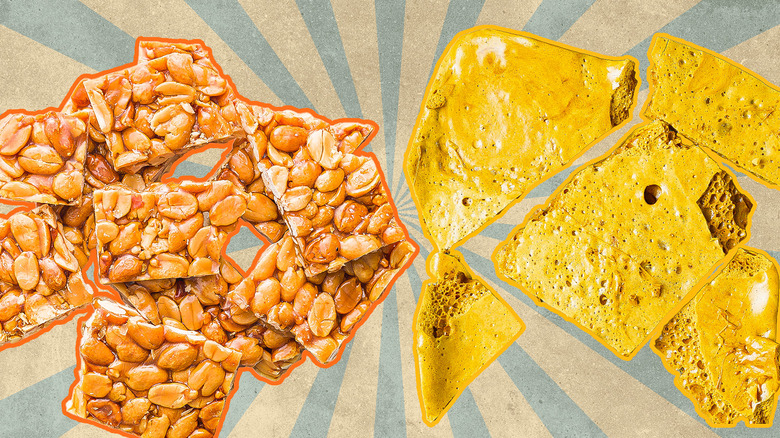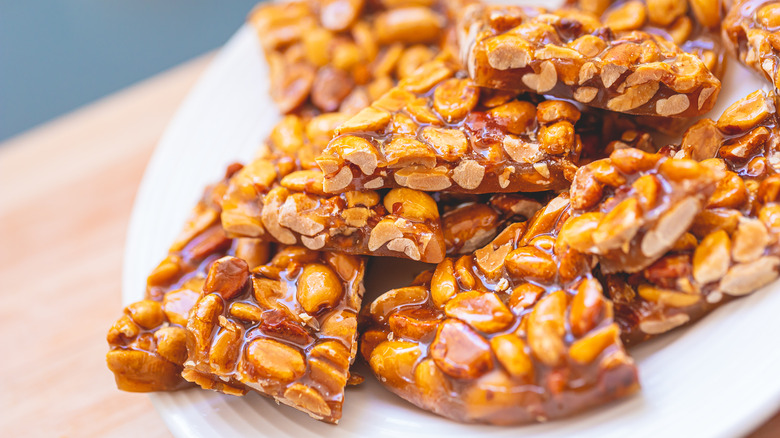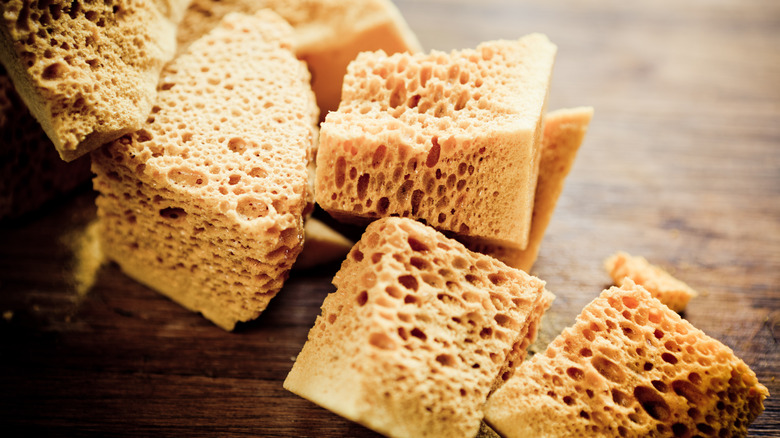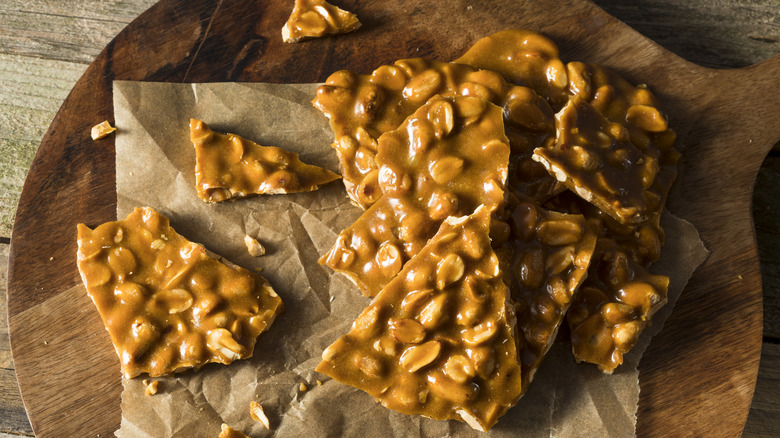Brittle Vs Honeycomb Candy: What's The Difference?
Flavor is always hyped when it comes to desserts, but careful thought should be given to their texture as well. No matter how delicious a soft and creamy after-meal treat is, it becomes too one-note when there's nothing crunchy to balance it and keep the palate interested. Give the usual sprinkles, chocolate chips, and candied nuts a break and go for brittle and honeycomb toffee candy instead. Honeycomb candy's caramel notes have a subtle bitterness that keeps the confection from being too sweet.
Meanwhile, brittle, aka nut brittle, has the addition of nuttiness and saltiness to balance the sugar. Both are delicious on their own, but when crumbled and used as toppings on ice cream, dipped in chocolate, or incorporated into baked treats, they create more decadent desserts. These two candies have major similarities: They both include water, sugar, sweet syrup, and baking soda as part of their list of ingredients. They similarly require boiling the mixture of sugar, sweet syrup, and water in medium heat up until a specific temperature.
Both also need syrup's viscosity to function as an interferent to sugar's crystallization so they don't take on a gritty texture. Finally, both typically have baking soda added in before the liquified sugar hardens so the fizz it creates aerates and expands the hot liquid. But the two have key differences, as well, with brittle's use of nuts being the biggest one. Get to know their other distinctions to determine which sugary confection to make for the desserts you have in mind.
What is brittle?
Nut brittle is a hard and flat sugar candy that's embedded with nuts and, sometimes, toasted seeds. Its most popular variant is the classic peanut brittle, whose origins aren't clear. Some believe it resulted from a taffy-making mistake made sometime in 1890, while others credit Southern folklore hero Tony Beaver, who was said to have poured peanuts and molasses into a river to dam and keep it from flooding a town.
Another story is that the Celts had long been mixing sugar with peanut butter to create a sweet holiday treat, and Irish immigrants brought the recipe to the U.S. in the 1830s. Regardless of its murky history, peanut brittle's crunch and sweet and salty flavor made it so popular among Americans that every 26th of January is deemed National Peanut Brittle Day. It's also pretty easy to make at home, as long as you have a candy or digital thermometer on hand.
Making basic brittle requires letting the mixture of water, sugar, and corn syrup boil on medium heat until it reaches 280 degrees Fahrenheit. The nuts are then added in and allowed to cook with the liquid. At 300 degrees Fahrenheit, the whole mixture is removed from the heat so baking soda can be added. Not all brittle recipes require this ingredient, but the small air pockets it creates as it froths upon contact with the hot, caramelized sugar make the candy a little easier to crack and bite into.
What is honeycomb candy?
Honeycomb candy is said to originate from the British-Irish isles. It started off as toffee until baking soda was added to the toffee-making process in the 19th century. You might think it contains honey because of its name — and some recipes include it — but it actually got its label from the honeycomb-like air pockets formed by the fizz of baking soda.
Among the Irish and the English, honeycomb candy is called cinder toffee, in reference to its coal-like appearance. In Scotland, it's known as puff candy, while New Zealanders refer to it as hokey pokey, frequently using it as a topping for vanilla ice cream. Honeycomb candy is also called dalgona in Korea, where the tradition is to make a game out of breaking off the shapes imprinted on thin, brittle dalgona cookies as cleanly as possible.
Similar to nut brittle, making honeycomb candy requires bringing the ingredients to a boil over medium-high heat. As soon as it reaches 300 degrees Fahrenheit, the mixture is removed from the stove and baking soda is added in. Once the mixture cools down and hardens, the resulting candy has a light and airy mouthfeel despite its stiff structure.
Brittle's texture is all about the snap
Because brittle is much denser than honeycomb candy, there's a discernible snap when you break its hardened sugar and the pieces of nuts embedded in it. Sometimes, though, you'll encounter a brittle that doesn't have that satisfying crunch. This happens when the mixture of boiling sugar, syrup, and nuts wasn't allowed to reach at least 300 degrees Fahrenheit before the baking soda gets added.
In the candy-making process, there is such a thing as the hard-crack stage. It happens when the ingredients are allowed to boil and reach the 300-to-310-degree-Fahrenheit range. At such a high heat, the syrup used in the candy mixture begins to create separate brittle threads that will crack when bent. Nut brittle needs to reach this stage so that when it cools down and solidifies once again, it will turn rock hard — but is not too difficult to snap into pieces.
Honeycomb candy must also reach the hard-crack stage. However, since it's less compact than brittle, it's merely crunchy when bitten into. The sugar is also easier to break than brittle, with no other element to hold the structure together.
Honeycomb candy requires more baking soda
The noticeable difference in density between honeycomb candy and brittle is due to the varying amounts of baking soda used to make them. Honeycomb candy needs more of it to create the numerous and more distinct holes on its surface. For comparison, an 8-by-4 inch sheet pan of peanut brittle requires only a teaspoon, whereas a 9-by-9 inch sheet pan of honeycomb candy uses a tablespoon of baking soda.
It's important to follow the amount dictated by the honeycomb candy recipe you're making so it gets that light and airy mouthfeel that the confection is known for. Too little, and it won't have big enough air bubbles to create this specific texture. Be careful not to use an excessive amount, either. The sugar would aerate so much that the air bubbles will simply escape rather than set. Your honeycomb candy might also develop a metallic aftertaste to it since some of the baking soda may not fizz at all.




